|
The Fish and the Flies
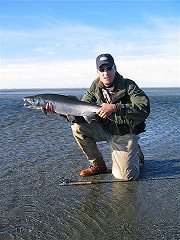 Coho Salmon - also known as silver salmon usually are one of the most popular species for fly fisherman. Their range extends from California’s Monterey Bay to Point Hope, Alaska (U.S. Fish and Wildlife Service Fairbanks Fish & Wildlife Field Office, 2006). They begin appearing in the salt, near their spawning streams in the late summer, and usually enter their spawning rivers with fall freshets. Some rivers, however have early and late runs of these popular fish for the fly fisherman and their also is a non-migratory Coho that which actually comprise the largest group of fish caught on the fly. That variety is common in inland bodies of salt water in Alaska, British Columbia, and Puget Sound. The inland varieties tend to be smaller than the migratory varieties because the ocean cousins have more feeding opportunities and a shorter lifespan (Johnson, Ferguson, & Trotter, 1985). Coho Salmon - also known as silver salmon usually are one of the most popular species for fly fisherman. Their range extends from California’s Monterey Bay to Point Hope, Alaska (U.S. Fish and Wildlife Service Fairbanks Fish & Wildlife Field Office, 2006). They begin appearing in the salt, near their spawning streams in the late summer, and usually enter their spawning rivers with fall freshets. Some rivers, however have early and late runs of these popular fish for the fly fisherman and their also is a non-migratory Coho that which actually comprise the largest group of fish caught on the fly. That variety is common in inland bodies of salt water in Alaska, British Columbia, and Puget Sound. The inland varieties tend to be smaller than the migratory varieties because the ocean cousins have more feeding opportunities and a shorter lifespan (Johnson, Ferguson, & Trotter, 1985).
Coho salmon range in size from six to 12 lbs. but they can get up into the 20s. The inland varieties average around 4 to 6. They are all known for their aerial acrobatics when hooked, and fish in the upper teens can wage a formidable battle. An 8 weight rod would probably fit the bill in most cases unless you are targeting a known population of larger fish. Flies should primarily imitate baitfish like herring, sand lances and candlefish. There are many variations of baitfish patterns, but just a few are Beer Belly , Les Johnson’s Herring Fly, and Polar Herring (Herring Flies); Alaska Candlefish, Lambuth Candlefish, Miheve Candlefish (Candlefish Flies); Roselyn Sandlance, the Floating Vineyard Eel tied by Bill Lovelace, and Eelie Variant (Sand Lance Flies).
Chinook salmon, also known as King, Tyee, and Blackmouth is the giant of the family and one of the most sought after fish by commercial fisheries and bait a lure anglers. The average weight at maturity is between 18 to 20 lbs, but they do grow much larger. One taken by commercial nets weighed 126 lbs and they have been caught up to 92 lbs by Alaskan sport fisherman. The range of the wild populations extends from the Ventura River in California to Hope Point in Alaska. Wild runs used to exist as far south as San Diego but hey have all but disappeared. Many wild runs have been supplanted with hatchery fish. Hatchery runs exist now in the San Joaquin river system of California and there are transplanted runs in the Great Lakes (Busch, 2000). The nice thing about Chinook for the angler is that they can be found as they ready enter their natal rivers almost year round depending on location. Johnson, Ferguson, & Trotter, (1985, p.20) identify the run timing most clearly,
…The Columbia River has a spring run that enters the river from February through May; a summer run arrives from June through July; and a fall run from August through September, with some in October. The Sacramento River has not only a spring and fall run, but also a winter run from November through February. In general, the more southern rivers have multiple runs, but moving north these are reduced to a single fall run in rivers like the Yukon in Alaska.
Chinook do not exhibit the schooling habits that are found with the other Pacific salmon. They are 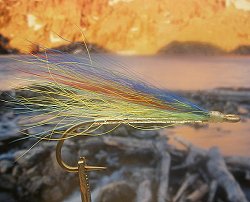 loners that often do inhabit deeper water. During their migration, they may be at depths of 70 to 120 feet even when they are close to shore. But Chinook are not always a deep water fish. Barry M. Thornton notes that he has often found them feeding in the same area as Coho. They can, in fact, be found at a range of depths. At times they are taken by commercial gillnets near the surface and at other times they have been taken as deep as 350 feet. If you know of a stream or river where they spawn, you may catch them at the mouth in the estuary near the shoreline or in kelp beds near drop offs. I have two favorite rivers on Puget Sound where I find them in the estuary as they are beginning to make their spawning runs. Like the Coho, there are also strains of resident Chinook or Blackmouth as they are often called, in the inshore bodies of water, like the Puget Sound, the Straight of Georgia, and the Inland Waterway of Alaska (Johnson, Ferguson, & Trotter, 1985). These fish make their homes year round in those bodies of water and are usually smaller than their migratory cousins. loners that often do inhabit deeper water. During their migration, they may be at depths of 70 to 120 feet even when they are close to shore. But Chinook are not always a deep water fish. Barry M. Thornton notes that he has often found them feeding in the same area as Coho. They can, in fact, be found at a range of depths. At times they are taken by commercial gillnets near the surface and at other times they have been taken as deep as 350 feet. If you know of a stream or river where they spawn, you may catch them at the mouth in the estuary near the shoreline or in kelp beds near drop offs. I have two favorite rivers on Puget Sound where I find them in the estuary as they are beginning to make their spawning runs. Like the Coho, there are also strains of resident Chinook or Blackmouth as they are often called, in the inshore bodies of water, like the Puget Sound, the Straight of Georgia, and the Inland Waterway of Alaska (Johnson, Ferguson, & Trotter, 1985). These fish make their homes year round in those bodies of water and are usually smaller than their migratory cousins.
You should always use heavier rods, 9 - 10 wt or better to fly fish for Chinook. The fly lines depend on whether you are fishing the deeper bluewater or the shallower estuaries. Ken Hanley (2003) suggests using shooting heads, 500 grains at least, or lead heads for fishing the bluewater and standard sink-tips or shooting heads of 200- 300 grains for estuary fly fishing..
Despite having this availability and great potential for fly fisherman, of all the Pacific salmon varieties, the Chinook is perhaps, the most avoided by them when fishing the salt. The reasons vary, but one is that as already mentioned, they often inhabit deeper water than Coho and Pink salmon and considered to be unreachable. Another is that they are thought to be the least likely to take a fly. It is too bad, however, that fly fisherman have these perceptions because they are missing the opportunity for one of the most remarkable experiences of a lifetime. The myth that they cannot be taken on a fly is dispelled by those that know better. They may be difficult, but they are not easy on any gear. Bush (2000, p. 31) writes, “Of all the salmon, Chinook and Coho are the two species most likely to take a fly or baited hook in salt water.” Barry M. Thornton (1995, p. 46) proclaims, “I have had many memorable fly fishing experiences with this powerhouse, this racehorse, this King of the Pacific Salmon family-the Chinook.” Hanley, (2003, p. 66) matter-of-factly states, “I have seen numerous fly-caught Chinook well over twenty pounds. Both bluewater and estuary specimens will be sure to test your mettle.” Jim Crawford (1995, p.41) makes us dream about catching them with, “I get drooly when I talk about Chinooks. There isn’t a more exciting fish anywhere, I guess because they are so difficult on flies in the ocean…”
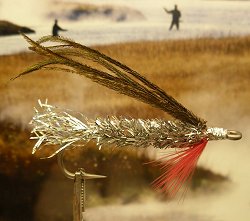 Flies for deep water should, like those for Coho, imitate the large baitfishes that are their primary forage, like herring, anchovies, and sand lances. Some of the patterns for those flies have already been mentioned in the Coho section and there are many more that can be found in the literature. One that is especially worth mentioning is perhaps the simplest. Barry M. Thornton recommends, in fact, that simpler patterns suggestive of bait fish are often highly effective. As a matter of fact, the simpler the fly is, the more likely it is to catch fish. If you wish to be convinced of that fact, read, Mr. Thornton dissertation about it in his book, Saltwater Fly Fishing for Pacific Salmon, pages 115 to 118. I think it is the most convincing argument I have ever read because it comes through years of experimentation mixed with his logical good sense and success. He also convinces the reader that his fly, the Silver Thorn, is his most successful fly because of its simple design, Flies for deep water should, like those for Coho, imitate the large baitfishes that are their primary forage, like herring, anchovies, and sand lances. Some of the patterns for those flies have already been mentioned in the Coho section and there are many more that can be found in the literature. One that is especially worth mentioning is perhaps the simplest. Barry M. Thornton recommends, in fact, that simpler patterns suggestive of bait fish are often highly effective. As a matter of fact, the simpler the fly is, the more likely it is to catch fish. If you wish to be convinced of that fact, read, Mr. Thornton dissertation about it in his book, Saltwater Fly Fishing for Pacific Salmon, pages 115 to 118. I think it is the most convincing argument I have ever read because it comes through years of experimentation mixed with his logical good sense and success. He also convinces the reader that his fly, the Silver Thorn, is his most successful fly because of its simple design,
…It was truly a remarkable day to remember, but success was the direct result of the basic silver-bodied fly, the Silver Thorn.
Since that particular trip, many additional trips have given me the opportunity to add and modify this simple pattern but interestingly, when the strikes are slow, I have found that new patterns with additions of color and material are not often selected by timid salmon (Thornton, 1995, p. 126).
Mr. Thornton has a list of patterns in Saltwater Fly Fishing for Pacific Salmon which, like the Silver Thorn, are in keeping with his philosophy of the simpler-the-better. A couple others that he has had success with for Chinook are the Pink, Red, and Blue Minnow, and Silver Blue Jay. Read the notes about these flies as they are usually equally effective for other Pacific salmon, but also read the book. Barry M. Thornton’s knowledge and experience is invaluable. His notes about the color variations of the flies and the way they are tied can often mean the difference between success and frustration.
Pink salmon, also known humpback salmon or humpies, can be found in waters readying to enter their spawning streams from June to September throughout their range. Their range extends from La Jolla, California north to the Arctic Ocean, east to the Mackenzie River Delta, and west across Siberia to the Lena River (U.S. Fish and Wildlife Service Fairbanks Fish & Wildlife Field Office, 2006). What makes these fish very unique is that their runs occur most often every two years, instead of yearly as with all the other salmonids. In Washington and Western Alaska, the spawning runs occur almost exclusively in odd numbered years, while they are more balanced between odd and even years in British Columbia and the remainder of Washington (Johnson, Ferguson, & Trotter, 1985). They are the most abundant but smallest of the Pacific salmon species, averaging 3 to 5 lbs. They are fun for the fly fisherman because they often aggressively take a fly and put up one heck of a fight. You don’t need large 9-10 weight rods for these fish. Taken on a 6-7 weight rod, they feel like a much larger fish than they are. Flies for Pinks, as with any other species of fish, are largely a matter of personal experience, but one theme that is consistent is that Pinks like pink. Ken Hanley writes in Fly Fishing the Pacific Inshore,
Fly patterns needn’t be complicated. The fish appear to key in on tiny euphausiids, other estuary shrimp, and krill. Pinks find pink patterns pretty. Hook sizes 4-6 are great all-around choices…Think small, and think sparse… Patterns such as the CDC Shrimp and the Diamond Shrimp are perfect for pinks (Hanley, 2003, p. 63).
Early in the season, you may need a boat to locate Pinks, but later they can be found cruising the 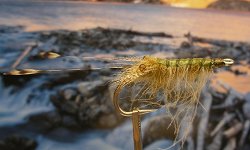 shoreline in huge schools as they prepare to enter their spawning creek or river. In the tidal flats, they will often enter their spawning streams and hold in pools with the receding tides as they acclimatize to the fresh water. Both of these areas are good areas for wading fly fisherman to target these feisty salmon. One point to remember, however – On my first outing for Pinks, I noticed how easily the large schools seemed to spook, when I cast my fly directly into them. I did not have success, until I cast to the side, though I had to guess by the wake in the water where the actual side of the school ended. The only time I was able to observe this directly, was when I fishing in fresh water. One pool downstream from me, which was a little shallow, but under the shade of an overhanging tree, held about 10-15 Pinks. I knew I could not get too close without spooking them and also knew from my experience in the salt that I could not cast so that the belly of my line swept over them. Instead, I cast quartering downstream to the opposite bank and stripped enough line so that tippet and fly made its arc to the side and then in front of the school. As it came around, now with the fly behind the leader, I watched at least five of the fish move out of the pool, chasing the fly until one beat the rest to the prey and struck. That was the only fish I took from that pool, but it was a good lesson, I think, to apply for all situations. shoreline in huge schools as they prepare to enter their spawning creek or river. In the tidal flats, they will often enter their spawning streams and hold in pools with the receding tides as they acclimatize to the fresh water. Both of these areas are good areas for wading fly fisherman to target these feisty salmon. One point to remember, however – On my first outing for Pinks, I noticed how easily the large schools seemed to spook, when I cast my fly directly into them. I did not have success, until I cast to the side, though I had to guess by the wake in the water where the actual side of the school ended. The only time I was able to observe this directly, was when I fishing in fresh water. One pool downstream from me, which was a little shallow, but under the shade of an overhanging tree, held about 10-15 Pinks. I knew I could not get too close without spooking them and also knew from my experience in the salt that I could not cast so that the belly of my line swept over them. Instead, I cast quartering downstream to the opposite bank and stripped enough line so that tippet and fly made its arc to the side and then in front of the school. As it came around, now with the fly behind the leader, I watched at least five of the fish move out of the pool, chasing the fly until one beat the rest to the prey and struck. That was the only fish I took from that pool, but it was a good lesson, I think, to apply for all situations.
So, remembering that Pink is the best color to entice Pink salmon, take a good selection of these on your excursions when you are targeting them. I have mentioned the flies recommended by Ken Hanley above. Here are several recommended by other experienced fly fisherman. Barry M. Thornton likes the Pink Eve for Pinks. He calls it “…the most effective and consistent fly I have found for pink salmon.” Read more of his notes about the fly on the pattern page. Another that he likes is the Pink and Red Glennis.
Chum Salmon, which are also known as dog salmon, are not as sought after as a food fish, and in recent years have become more popular as a quarry for fly fisherman. That may be partly due to the fact that it is not as valuable to the commercial fishery (except to the Japanese, who use the flesh for Sushi and the roe for caviar) as the other Pacific salmon and so there is an abundance of them to be found, as early as June to as late as January. It is good that they have been discovered as a quarry worthy of the sport, because they have for quite some time been known as the dark sheep of the five varieties. Some say that the nickname “dog” comes from the fact that they grow huge canine like teeth during their spawning season. Others say it comes from the fact that due to the bland taste of the meat, coastal native fisherman would only feed the flesh to their dogs. In either case, the name has stuck but the reputation is not deserved. Many have discovered that the fish makes excellent fare when smoked and seek it out just for that reason, and others have discovered that Chum salmon can put up a ferocious battle when hooked. Furthermore, they will readily attack a fly, in fresh and salt water. The mature fish which averages around ten lbs., but fish of twelve to fifteen are common. Occasionally, a brute of around twenty lbs. may find itself hooked to the other end of your leader.
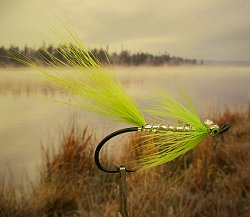 Chum salmon range sporadically from the San Lorenzo River in California to the Mackenzie River in the Northwest Territories of Canada, according to Busch, (2000), and there are small runs in the Sacramento and Klamath River systems of California, the Tillamook Bay and Kilchis River systems of Oregon. He notes that the only state with large runs is Alaska, with a dozen or so streams of British having them. Washington residents, however, may tell you otherwise, as they are very familiar with huge runs of Chum salmon entering the streams of south Puget Sound. Estuary fly fishing for Chum has as a matter of fact become quite popular for the fish, many of which travel back and forth along the shoreline in massive schools before making their rush to enter their natal streams, rivers and creeks. The schools of Chum are unmistakable as the water boils with their frantic activity. Chum salmon range sporadically from the San Lorenzo River in California to the Mackenzie River in the Northwest Territories of Canada, according to Busch, (2000), and there are small runs in the Sacramento and Klamath River systems of California, the Tillamook Bay and Kilchis River systems of Oregon. He notes that the only state with large runs is Alaska, with a dozen or so streams of British having them. Washington residents, however, may tell you otherwise, as they are very familiar with huge runs of Chum salmon entering the streams of south Puget Sound. Estuary fly fishing for Chum has as a matter of fact become quite popular for the fish, many of which travel back and forth along the shoreline in massive schools before making their rush to enter their natal streams, rivers and creeks. The schools of Chum are unmistakable as the water boils with their frantic activity.
Now, due to the fact that Chum salmon spawn short distances from salt water, they lose their brightness early and start taking on their spawning colors. For this reason, it is also believed that they do not have as much significance for fly fisherman. In Fly Fishing for Pacific Salmon, Johnson, Ferguson, & Trotter, (1985, p.24) state,
They are therefore, not much of a prize to the fly fisherman unless he nabs them when they first arrive in coastal areas and are still actively feeding. They are truly spectacular fighters at such times.
It is just that reason, however, that they are valuable to the estuary fly fisherman, where they can be “nabbed” early in their runs. Many of these fish may already have their spawning colors, but still put up a fight worthy of any fly fisherman’s efforts to pursue them.
Ken Hanley recommends using 8 to 10 weight rods, preferring the heavier tackle for bluewater and the lighter for the estuary. Although I have not fished bluewater conditions for them, I concur that the 8 weight is adequate along the shore. Hanley recommends the same lines that he uses for Coho – Type IV or faster sinking lines or shooting heads, leaders of 9 or less feet, and tippet strengths from 12 to 15 lbs. I usually go with a sinking tip for deeper water and a floating line for shallow water, because the estuary is affected by the tides. Chum is often found in shallow water as they swim along the shoreline or through the tidewater pools.
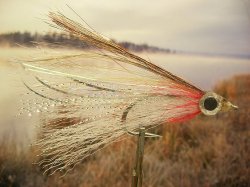 Mr. Hanley recommends again that fly patterns that imitate baitfish, attractors, or tidewater shrimp, are best used for Chum salmon, but that smaller is better – size 2 to 1/0. His specific recommendations are Alfs, Comets, Fatal Attractions, and Pearl Yetis. Most experienced fly fisherman who have fished for chum know that patterns with chartreuse or green work well in fresh water and I have found that attractors in the same colors work well in the salt – at least when the fish are near entering their spawning waters. Mr. Hanley recommends again that fly patterns that imitate baitfish, attractors, or tidewater shrimp, are best used for Chum salmon, but that smaller is better – size 2 to 1/0. His specific recommendations are Alfs, Comets, Fatal Attractions, and Pearl Yetis. Most experienced fly fisherman who have fished for chum know that patterns with chartreuse or green work well in fresh water and I have found that attractors in the same colors work well in the salt – at least when the fish are near entering their spawning waters.
Sockeye Salmon, also known as red or blueback salmon are the second most abundant of the Pacific salmon, and have the most value to commercial fisherman due to their bright-orange red flesh which many think is the most delicious of all the varieties. Their range extends from the Sacramento River in California to Point Hope in Alaska; however they are rare south of the Columbia River (Busch, 2000). Sockeye almost always spawn in rivers which have lakes in their headwaters because the fry develop up to three years in freshwater. They emerge from their gravel around May to June and head to the lake where they spend another one to four years (usually about two) developing. When they are about three to five inches they head out to salt water. Once in the ocean they move along the coast, actively feeding, then head out to the North Pacific and Bering Sea into an area that extends as far as 2600 miles - south to the Oregon-California Border and north to Gulf of Alaska. Adults reach maturity from three to eight years, most commonly at about four to five and weigh between three to eight lbs. (with an occasional bruiser in the 10 to 12 lb range). They travel in huge schools back to their native waters, still actively feeding, and usually located close to the surface in water less than 50 feet. Commercial trawlers that know the path and timing of the migration are able to drop their nets and haul in tremendous amounts of these fish, which, unfortunately, can take its toll on the populations. Many stocks have suffered setbacks in recent years which have been difficult if not impossible to recover from.
Sockeye have a reputation as being one of the easiest to catch with a fly in their spawning rivers but in the open ocean of being one of the toughest to catch. The reason for the difficulty in catching them has to do with their life history and morphology. In the open ocean fly fisherman must know the timing of the runs because the schools travel quickly, up to 30 miles per day, and although they travel close to the surface and are actively feeding, their teeth are very tiny. It is not until they enter their spawning streams that they grow the large canine-like teeth. Once there, they are easily caught, but only because they travel in very large schools, not because they are actively feeding. In bluewater they may be voraciously feeding on almost any available food to supplement their bodies with protein before their final journey to their spawning grounds. There primary diet are the tiny zooplankton, fish and crab larvae, euphasiids, and insects that they fed on when they first left for the sea, but they will occasionally even feed on the same baitfish that Coho and Chinook prefer. Baitfish must be difficult to catch with there tiny teeth, however. Jim Crawford writes about this fact in Salmon to a Fly, Fly Fishing for Pacific Salmon in the Open Ocean,
Of all the salmon that inhabit coastal waters, sockeye are unquestionably the most difficult to catch on a fly cast in the open ocean. …In the final weeks before heading up home river systems, adult sockeye have been known to engorge on any available feed – even herring, needlefish and shrimp- to supplement needed protein. And grabbing a baitfish is no small feat for a sockeye. They have no teeth until they reach spawning color… (Crawford, 1995, p. 44).”
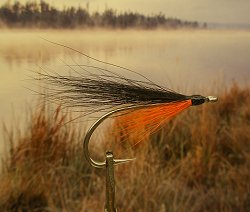 Mr. Crawford goes on to say that he compensated for this by modifying some of his Coho flies and inventing some shrimp patterns. Keep in mind that I am relating this entirely from his perspective. I have no experience fishing for them in either the open ocean or in their spawning rivers because there are no local runs. Barry M. Thornton does not address Sockeye fishing in his book and Ken Hanley only devotes a couple paragraphs. There is a well-known run through Lake Washington in Seattle; however, that receives a lot of local coverage in the media. That run has in recent years suffered from low returns and only been open to fishing when stocks are projected to be good. The most productive tackle, when it is open has been a bare red hook! Mr. Crawford goes on to say that he compensated for this by modifying some of his Coho flies and inventing some shrimp patterns. Keep in mind that I am relating this entirely from his perspective. I have no experience fishing for them in either the open ocean or in their spawning rivers because there are no local runs. Barry M. Thornton does not address Sockeye fishing in his book and Ken Hanley only devotes a couple paragraphs. There is a well-known run through Lake Washington in Seattle; however, that receives a lot of local coverage in the media. That run has in recent years suffered from low returns and only been open to fishing when stocks are projected to be good. The most productive tackle, when it is open has been a bare red hook!
Jim Crawford relates that he compensated by developing smaller versions of his favorite Coho like the Firecracker, Polar Herring, and Polar Shrimp. (hint – you can use these for Coho and Chinook too), and as he notes, “…tied a dozen very small very sparse fluorescent-pink, red and lime-green shrimp patterns in single colors on size 10 hooks (Crawford, 1995, p. 75).”
Ken Hanley’s choice of flies are, “… a Green or Gold Comet, the Sockeye Boss, and the Sockeye Special, sizes 2 through 8. For shrimp imitations…Deer Hair Shrimp, CDC Shrimp and the Diamond Shrimp (Hanley, 2003 p. 65).”
Ken Hanley, who is the most specific as we have seen about tackle, favors an 8 wt rod with a line selection the same as he recommends for Pinks.
Fly Selection Summary
I hope that as you read this you noted a common theme throughout – that the most popular and successful flies for ocean fishing are those that mimic the food source of the variety of Pacific salmon you are targeting. But there is a little more to it than that. It is not as important that the fly be realistic as it should be impressionistic. In other words you should try to match the size and activity of the bait source. That is why Barry M. Thornton likes his Silver Thorn. When fished through a school of fleeing baitfish, Salmon do not know the difference. Fished a bit slower, it can easily be confused for an injured baitfish. Consider what Mr. Thornton has observed about the behavior of feeding Coho,
…Surfacing effectively traps the herring, surrounded by the Coho, who will dart into the school, grabbing those unable to escape and crippling others as they dash by. The Coho quickly snap up those stunned and crippled herring and herein lies the secret for the fly fisherman- a feeding-frenzied salmon will grab a silver fly landing in the midst of this melee (Thornton, 1995, p. 23)!”
But, nothing about salmon fishing build down to an exact science and we are still learning. Each salmon is different and each angler the same. What one uses as a particular technique may work for him but not for others. Mr. Thornton puts it this way, “Saltwater fly fishing is still in its pioneer infancy and only if the angler uses his hunting instinct, is it possible to achieve success consistently (Thornton, 1995, p. 24).
Jim Crawford puts it even more succinctly,
Somewhere in the book are photographs of patterns, but as stated elsewhere almost any fly will work if it represents food, and if you hunt long enough and put yourself into feeding fish. Just be sure your fly reasonably matches size and color of bait and then concentrate on your retrieve (Crawford, 1995, p.26).
Now lest I give I give too much away by quoting the books that I recommend, a word of caution, then let me go on to tell you about the places and then the books themselves. Much of what I have written here is about bluewater fly fishing that can only be done from a boat. It is imperative that anyone who attempts to fish via boat have the proper equipment and boating skills to master the seas and manipulate the boat under all conditions. There should always be a partner available to steer while the other fishes should there be a need to move the boat while a fish is on. Never attempt to navigate the open ocean in a flimsy boat let alone do it by yourself.
The Fly Fishing <<Previous Page----------------Next Page >> The Places and the Literature |
